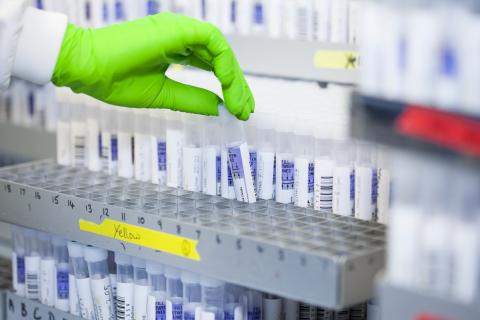New research from leading charity Anthony Nolan could pave the way for a change in how stem cell donors are selected and save the lives of more people with blood cancer and blood disorders.
The Anthony Nolan Research Institute (ANRI) has carried out the largest UK study into the factors that can make a stem cell transplant more successful.
The findings confirm a trend showing that the age of the donor can affect patient outcomes, with younger donors leading to better survival rates. It is also the first UK study to demonstrate that matching donors and patients who carry a common virus can offset a genetic mismatch.
Donors are currently selected on the basis of whether their tissue (HLA) type is a good match for the patient, with little known about what other donor factors play a role in patient survival. However, ANRI’s new research offers the potential to improve the success rate of transplants by identifying secondary factors that also play a role.
Lifesaving findings revealed
The research shows that selecting donors under 30 years old resulted in survival rates of 45 per cent, compared to 38.6 per cent for patients with donors over thirty. Anthony Nolan is the first UK stem cell register to lower the age limit for joining to 16, and introduce an upper age limit of 30. Other UK stem cell registers currently recruit up to the ages of 45 and 55.
The study also made the ground-breaking finding that matching the CMV status of the donor and the patient can have a significant benefit on patient survival. CMV (cytomegalovirus) is a common virus affecting an estimated 50-80% of the population, and is dormant in most healthy people. However, patients undergoing transplant have a weakened immune system, making it easy for the virus to reactivate. The researchers discovered that matching for CMV can offset a HLA mismatch; among HLA-mismatched patients, those who did not have a CMV-matched donor were 1.5 times more likely to die than those with a CMV match. This makes it possible to improve survival rates for patients with no HLA-matched donor by matching the CMV status of donor and patient.
As a result of the findings, experts at Anthony Nolan are exploring how to type donors for CMV when joining the stem cell donor register, to allow CMV status to be taken into account when transplant centres are selecting potential donors for a patient.
Professor Steven Marsh of the ANRI, one of the paper’s lead authors, said, ‘This breakthrough will help us discover new and more effective ways to make sure patients in need of a transplant get the best possible match to cure blood cancer and blood disorders.
‘Although everyone who donates gives a patient a second chance of life, this study confirms that younger donors lead to better transplant outcomes, and shows that Anthony Nolan is leading the way by targeting 16–30 year olds to join the register.
‘Moreover, by establishing that CMV matching has a significant impact on patient outcomes, we are making it easier for transplant centres to make informed choices about the donors they select for their patients.’
The paper, “Recipient/donor HLA and CMV matching in recipients of T-cell-depleted unrelated donor haematopoietic cell transplants”, was published today (Wednesday 3 May) in the journal Bone Marrow Transplantation. To read the full paper, visit: http://www.nature.com/bmt/journal/vaop/ncurrent/full/bmt2016352a.html
